New Insights into Fracture Porosity Estimations Using Machine Learning and Advanced Logging Tools
Abstract
:1. Introduction
2. Geological Background
3. Materials and Methods
3.1. Fracture Porosity Quantification
3.2. Predictive Modeling Approach
3.2.1. Exploratory Data Analysis
3.2.2. Machine Learning Algorithms
Artificial Neural Networks (ANN)
Hybrid Model Support Vector Machine-Artificial Neural Network (SVM-ANN)
4. Results and Discussion
4.1. Artificial Neural Network (ANN)
4.2. Support Vector Machines-Artificial Neural Network (SVM-ANN)
5. Conclusions
Author Contributions
Funding
Data Availability Statement
Conflicts of Interest
Appendix A
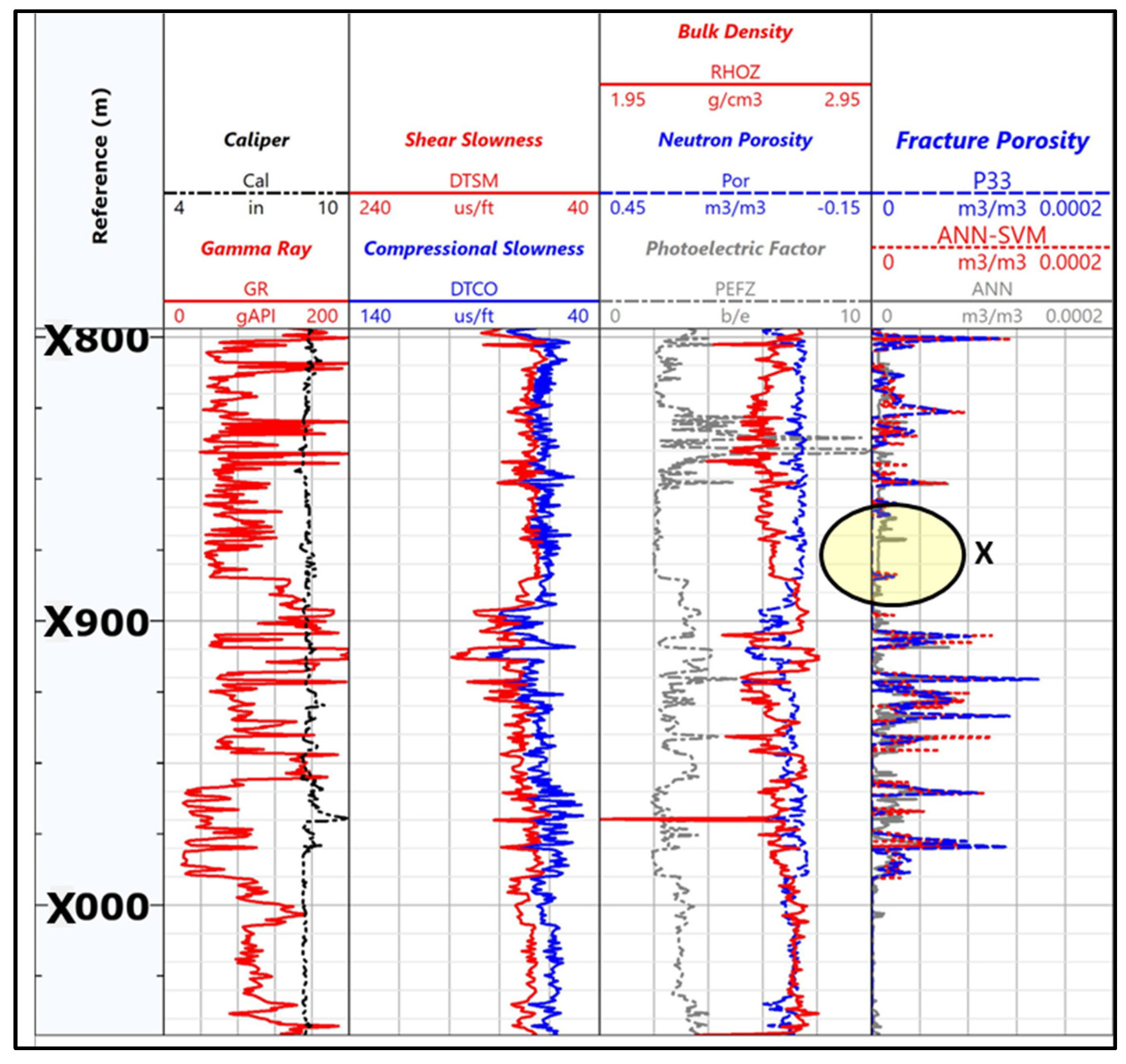


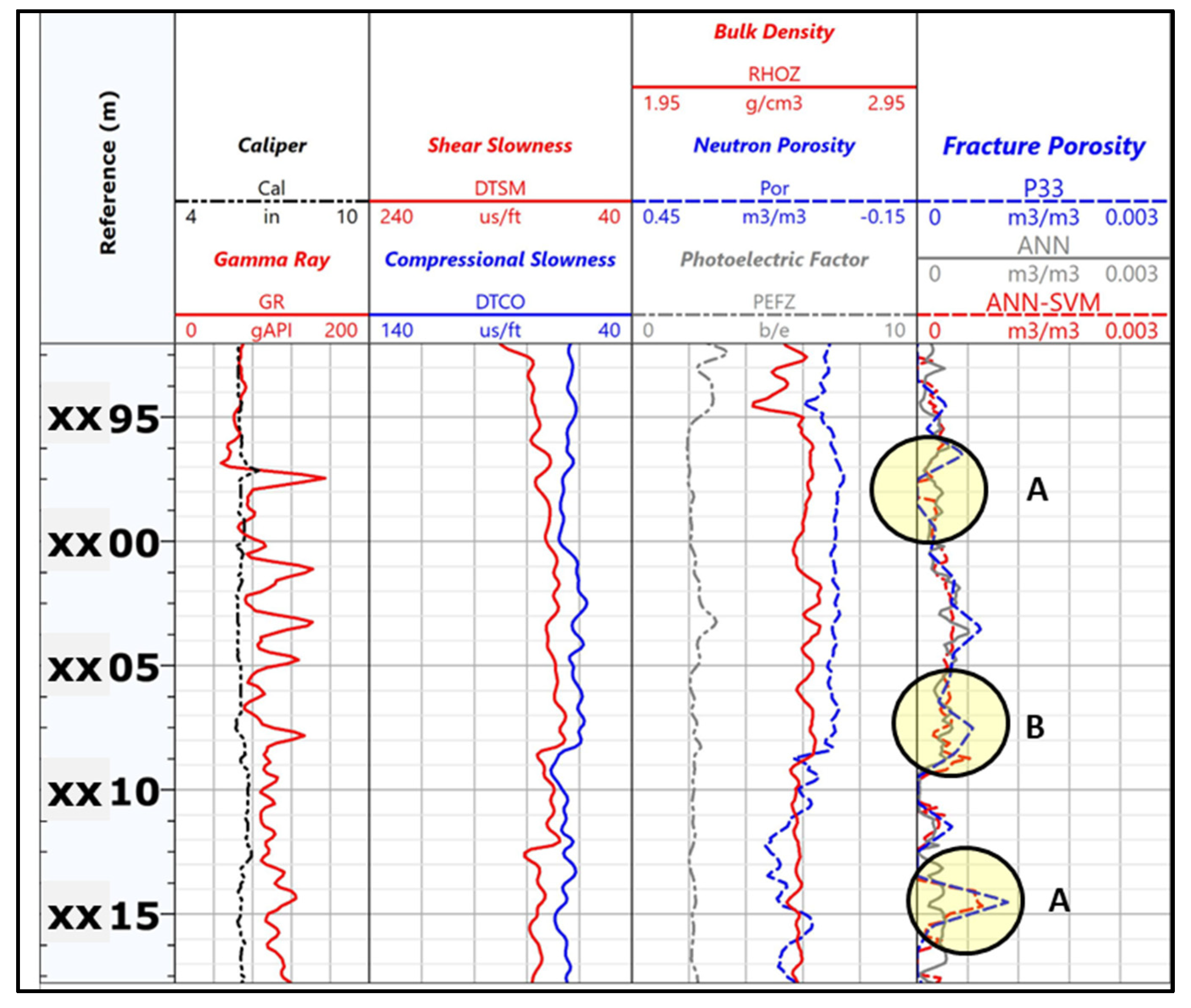
References
- Alagoz, E.; Wang, H.; Russell, R.T.; Sharma, M.M. New Experimental Methods to Study Proppant Embedment in Shales. In Proceedings of the 54th US Rock Mechanics/Geomechanics Symposium, Golden, CO, USA, 28 June–1 July 2020; OnePetro: Richardson, TX, USA, 2020. [Google Scholar]
- Gutmanis, J.C. Basement Reservoirs—A Review of Their Geological and Production Characteristics. In Proceedings of the IPTC 2009: International Petroleum Technology Conference, Doha, Qatar, 7–9 December 2009; European Association of Geoscientists & Engineers: Binnick, The Netherlands, 2009. [Google Scholar]
- Curtis, J.B. Fractured shale-gas systems. Am. Assoc. Pet. Geol. Bull. 2002, 86, 1921–1938. [Google Scholar] [CrossRef]
- Sulak, R. Ekofisk Field: The First 20 Years. J. Pet. Technol. 1991, 43, 1265–1271. [Google Scholar] [CrossRef]
- Alagoz, E.; Sharma, M.M. Investigating Shale-Fluid Interactions and Its Effect on Proppant Embedment Using NMR Techniques. In Proceedings of the 55th US Rock Mechanics/Geomechanics Symposium, Virtual, 18–25 June 2021; OnePetro: Richardson, TX, USA, 2021. [Google Scholar]
- Kharrat, R.; Ott, H. A Comprehensive Review of Fracture Characterization and Its Impact on Oil Production in Naturally Fractured Reservoirs. Energies 2023, 16, 3437. [Google Scholar] [CrossRef]
- Ameen, M.S.; MacPherson, K.; Al-Marhoon, M.I.; Rahim, Z. Diverse fracture properties and their impact on performance in conventional and tight-gas reservoirs, Saudi Arabia: The Unayzah, South Haradh case study. Am. Assoc. Pet. Geol. Bull. 2012, 96, 459–492. [Google Scholar] [CrossRef]
- Mahmood, M.N.; Guo, B. An Analytical Method for Optimizing Fracture Spacing in Shale Oil Reservoirs. In Proceedings of the SPE Liquids-Rich Basins Conference-North America, Odessa, TX, USA, 7–8 November 2019; OnePetro: Richardson, TX, USA, 2019. [Google Scholar]
- Laubach, S.; Marrett, R.; Olson, J. New directions in fracture characterization. Lead. Edge 2000, 19, 704–711. [Google Scholar] [CrossRef]
- Clarkson, C.; Haghshenas, B.; Ghanizadeh, A.; Qanbari, F.; Williams-Kovacs, J.; Riazi, N.; Debuhr, C.; Deglint, H. Nanopores to megafractures: Current challenges and methods for shale gas reservoir and hydraulic fracture characterization. J. Nat. Gas Sci. Eng. 2016, 31, 612–657. [Google Scholar] [CrossRef]
- Suhag, A.; Ranjith, R.; Aminzadeh, F. Comparison of Shale Oil Production Forecasting using Empirical Methods and Artificial Neural Networks. In Proceedings of the SPE Annual Technical Conference and Exhibition, San Antonio, TX, USA, 11 October 2017; SPE: Richardson, TX, USA, 2017. [Google Scholar]
- Chaki, S.; Routray, A.; Mohanty, W.K. Application of Machine Learning Algorithms for Petroleum Reservoir Characterization. In Handbook of Petroleum Geoscience; Wiley: Hoboken, NJ, USA, 2022; pp. 6–20. [Google Scholar] [CrossRef]
- Pothana, P.; Chatterjee, S.; Vln, A.; Deo, P.P. Prediction of Reservoir Parameters Using Support Vector Machines, A Machine Learning Approach. In Proceedings of the 5th CEWELL Symposium, Venice, Italy, 12–14 December 2020. [Google Scholar]
- Liang, B.; Liu, J.; You, J.; Jia, J.; Pan, Y.; Jeong, H. Hydrocarbon production dynamics forecasting using machine learning: A state-of-the-art review. Fuel 2023, 337, 127067. [Google Scholar] [CrossRef]
- Shelley, R.; Oduba, O.; Melcher, H. Machine Learning and Artificial Intelligence Provides Wolfcamp Completion Design Insight. In Proceedings of the SPE/AAPG/SEG Unconventional Resources Technology Conference, Houston, TX, USA, 4 May 2021; SPE: Richardson, TX, USA, 2021. [Google Scholar]
- Hegde, C.; Gray, K. Evaluation of coupled machine learning models for drilling optimization. J. Nat. Gas Sci. Eng. 2018, 56, 397–407. [Google Scholar] [CrossRef]
- Choubey, S.; Karmakar, G.P. Artificial intelligence techniques and their application in oil and gas industry. Artif. Intell. Rev. 2021, 54, 3665–3683. [Google Scholar] [CrossRef]
- Rahmanifard, H.; Plaksina, T. Application of artificial intelligence techniques in the petroleum industry: A review. Artif. Intell. Rev. 2019, 52, 2295–2318. [Google Scholar] [CrossRef]
- Zhong, R.; Salehi, C.; Johnson, R. Machine learning for drilling applications: A review. J. Nat. Gas Sci. Eng. 2022, 108, 104807. [Google Scholar] [CrossRef]
- Pankaj, P.; Geetan, S.; MacDonald, R.; Shukla, P.; Sharma, A.; Menasria, S.; Xue, H.; Judd, T. Application of Data Science and Machine Learning for Well Completion Optimization. In Proceedings of the Offshore Technology Conference, Houston, TX, USA, 3 May 2018; OTC: Springfield, MO, USA, 2018. [Google Scholar]
- Misra, S.; Li, H. Noninvasive fracture characterization based on the classification of sonic wave travel times. In Machine Learning for Subsurface Characterization; Elsevier: Amsterdam, The Netherlands, 2020; pp. 243–287. [Google Scholar] [CrossRef]
- Alipour, M.; Esatyana, E.; Sakhaee-Pour, A.; Sadooni, F.N.; Al-Kuwari, H.A. Characterizing fracture toughness using machine learning. J. Pet. Sci. Eng. 2021, 200, 108202. [Google Scholar] [CrossRef]
- Zheng, Y.; Li, J.; Lin, R.; Hu, H.; Gao, K.; Huang, L.; Sciences, A.; Alamos, L. Physics-Guided Machine Learning Approach to Characterizing Small-Scale Fractures in Geothermal Fields. In Proceedings of the 46th Workshop on Geothermal Reservoir Engineering, Stanford, CA, USA, 15–17 February 2021. SGP-TR-218. [Google Scholar]
- Singh, A.; Rabbani, A.; Regenauer-Lieb, K.; Armstrong, R.T.; Mostaghimi, P. Computer vision and unsupervised machine learning for pore-scale structural analysis of fractured porous media. Adv. Water Resour. 2021, 147, 103801. [Google Scholar] [CrossRef]
- Rabbani, A.; Babaei, M. Image-based modeling of carbon storage in fractured organic-rich shale with deep learning acceleration. Fuel 2021, 299, 120795. [Google Scholar] [CrossRef]
- Pandey, R.K.; Kumar, A.; Mandal, A.; Vaferi, B. Employing Deep Learning Neural Networks for Characterizing Dual-Porosity Reservoirs Based on Pressure Transient Tests. J. Energy Resour. Technol. Trans. ASME 2022, 144, 113002. [Google Scholar] [CrossRef]
- Zazoun, R.S. Fracture density estimation from core and conventional well logs data using artificial neural networks: The Cambro-Ordovician reservoir of Mesdar oil field, Algeria. J. Afr. Earth Sci. 2013, 83, 55–73. [Google Scholar] [CrossRef]
- Zerrouki, A.A.; Aïfa, T.; Baddari, K. Prediction of natural fracture porosity from well log data by means of fuzzy ranking and an artificial neural network in Hassi Messaoud oil field, Algeria. J. Pet. Sci. Eng. 2014, 115, 78–89. [Google Scholar] [CrossRef]
- Bhattacharya, S.; Mishra, S. Applications of machine learning for facies and fracture prediction using Bayesian Network Theory and Random Forest: Case studies from the Appalachian basin, USA. J. Pet. Sci. Eng. 2018, 170, 1005–1017. [Google Scholar] [CrossRef]
- Ding, Y.; Cui, M.; Zhao, F.; Shi, X.; Huang, K.; Yasin, Q. A Novel Neural Network for Seismic Anisotropy and Fracture Porosity Measurements in Carbonate Reservoirs. Arab. J. Sci. Eng. 2021, 47, 7219–7241. [Google Scholar] [CrossRef]
- Azim, R.A. Estimation of fracture network properties from FMI and conventional well logs data using artificial neural network. Upstream Oil Gas Technol. 2021, 7, 100044. [Google Scholar] [CrossRef]
- Boudjema, A. Évolution Structurale du Bassin Pétrolier “Triasique” du Sahara Nord Oriental (Algérie); Institut Français du Pétrole: Paris, France, 1987. [Google Scholar]
- Klitzsch, E.; Gray, C. The Structural Development of Parts of North Africa since Cambrian Time. In Proceedings of the Symposium on the geology of Libya: Tripoli, Tripoli, Lebanese, 14–18 April 1969; Faculty of Sciences, University of Libya: Benghazi, Libya, 1971; pp. 256–260. [Google Scholar]
- Beuf, S. Gres du Paleozoique Inferieur au Sahara; Publicqtions d l’Institut Français du Pétrole, Collection ‘Science and Techniques du Petrole’ No. 18; Technip: Paris, France, 1971. [Google Scholar]
- Robertson, A.H.F.; Dixon, J.E. Introduction: Aspects of the geological evolution of the Eastern Mediterranean. Geol. Soc. Lond. Spéc. Publ. 1984, 17, 1–74. [Google Scholar] [CrossRef]
- Guiraud, R.; Maurin, J.-C. Early Cretaceous rifts of Western and Central Africa: An overview. Tectonophysics 1992, 213, 153–168. [Google Scholar] [CrossRef]
- Ifrene, G.E.H.; Irofti, D.; Khetib, Y.; Rasouli, V. Shear Waves Anisotropy and Image Logs Integration for Improved Fracture Characterization. In Proceedings of the 56th U.S. Rock Mechanics/Geomechanics Symposium, Santa Fe, NM, USA, 26–29 June 2022. [Google Scholar] [CrossRef]
- Lander, L.A.; Silva, A.; Chiquito, J.; Cadena, A. Improved Fracture Characterization in the La Paz Field: A Case Study. In Proceedings of the SPE Latin American and Caribbean Petroleum Engineering Conference, Quito, Ecuador, 18 November 2015; OnePetro: Richardson, TX, USA, 2015. [Google Scholar]
- Maeso, C.; Dubourg, I.; Quesada, D.; ElNour, W.A. Uncertainties in Fracture Apertures Calculated from Electrical Borehole Images. In Proceedings of the International Petroleum Technology Conference, Riyadh, Saudi Arabia, 21–23 February 2022; OnePetro: Richardson, TX, USA, 2015. [Google Scholar] [CrossRef]
- Li, H. Statistical Learning Methods; Tsinghua Univ. Press: Beijing, China, 2012; pp. 95–115. [Google Scholar]
- Huang, Z.; Shimeld, J.; Williamson, M.; Katsube, J. Permeability prediction with artificial neural network modeling in the Venture gas field, offshore eastern Canada. Geophysics 1996, 61, 422–436. [Google Scholar] [CrossRef]
- Tariq, Z.; Elkatatny, S.M.; Mahmoud, M.A.; Abdulraheem, A.; Abdelwahab, A.Z.; Woldeamanuel, M. Estimation of Rock Mechanical Parameters Using Artificial Intelligence Tools. In Proceedings of the 51st US Rock Mechanics/Geomechanics Symposium, San Francisco, CA, USA, 25–28 June 2017; OnePetro: Richardson, TX, USA, 2017. [Google Scholar]
- Agatonovic-Kustrin, S.; Beresford, R. Basic Concepts of Artificial Neural Network (ANN) Modeling and Its Application in Pharmaceutical Research. J. Pharm. Biomed. Anal. 2000, 22, 717–727. [Google Scholar] [CrossRef]
- Ebrahimi, A.; Izadpanahi, A.; Ebrahimi, P.; Ranjbar, A. Estimation of shear wave velocity in an Iranian oil reservoir using machine learning methods. J. Pet. Sci. Eng. 2022, 209, 109841. [Google Scholar] [CrossRef]
- Wang, P.; Peng, S. On a new method of estimating shear wave velocity from conventional well logs. J. Pet. Sci. Eng. 2019, 180, 105–123. [Google Scholar] [CrossRef]
- Suthaharan, S.; Suthaharan, S. Machine Learning Models and Algorithms for Big Data Classification: Thinking with Examples for Effective Learning; Springer: Berlin/Heidelberg, Germany, 2016; pp. 207–235. [Google Scholar]
- Ying, X. An Overview of Overfitting and its Solutions. J. Phys. Conf. Ser. 2019, 1168, 022022. [Google Scholar] [CrossRef]

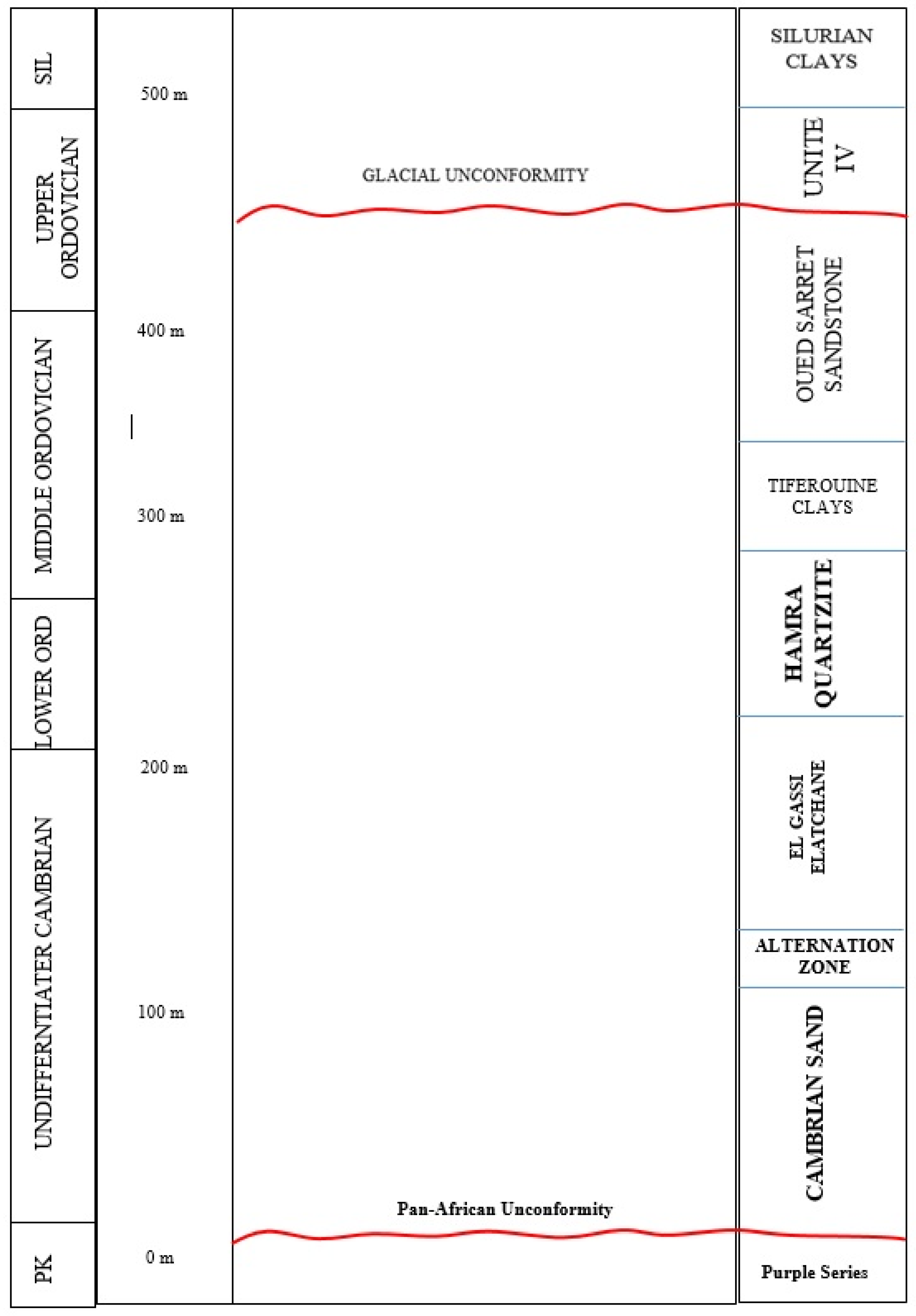
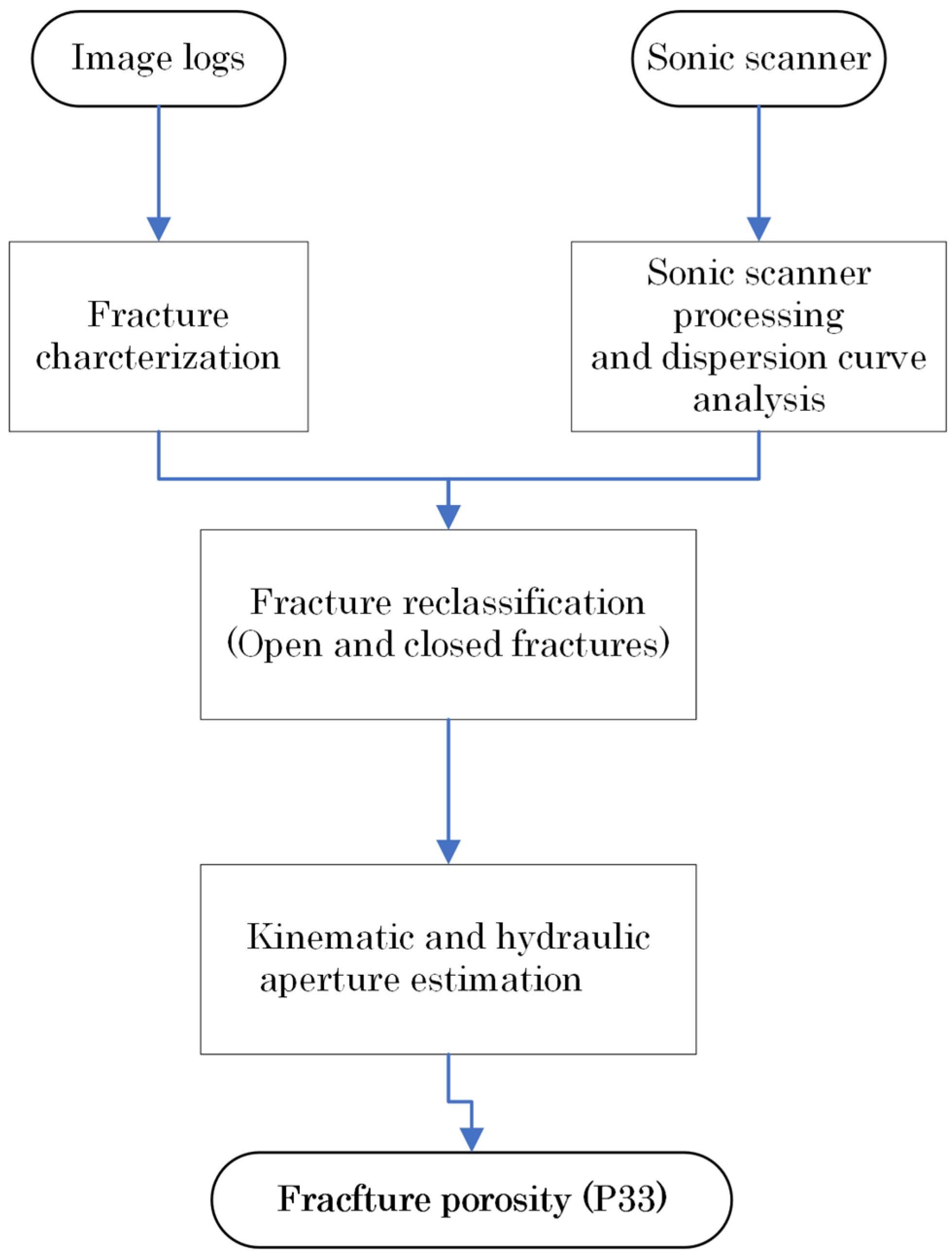


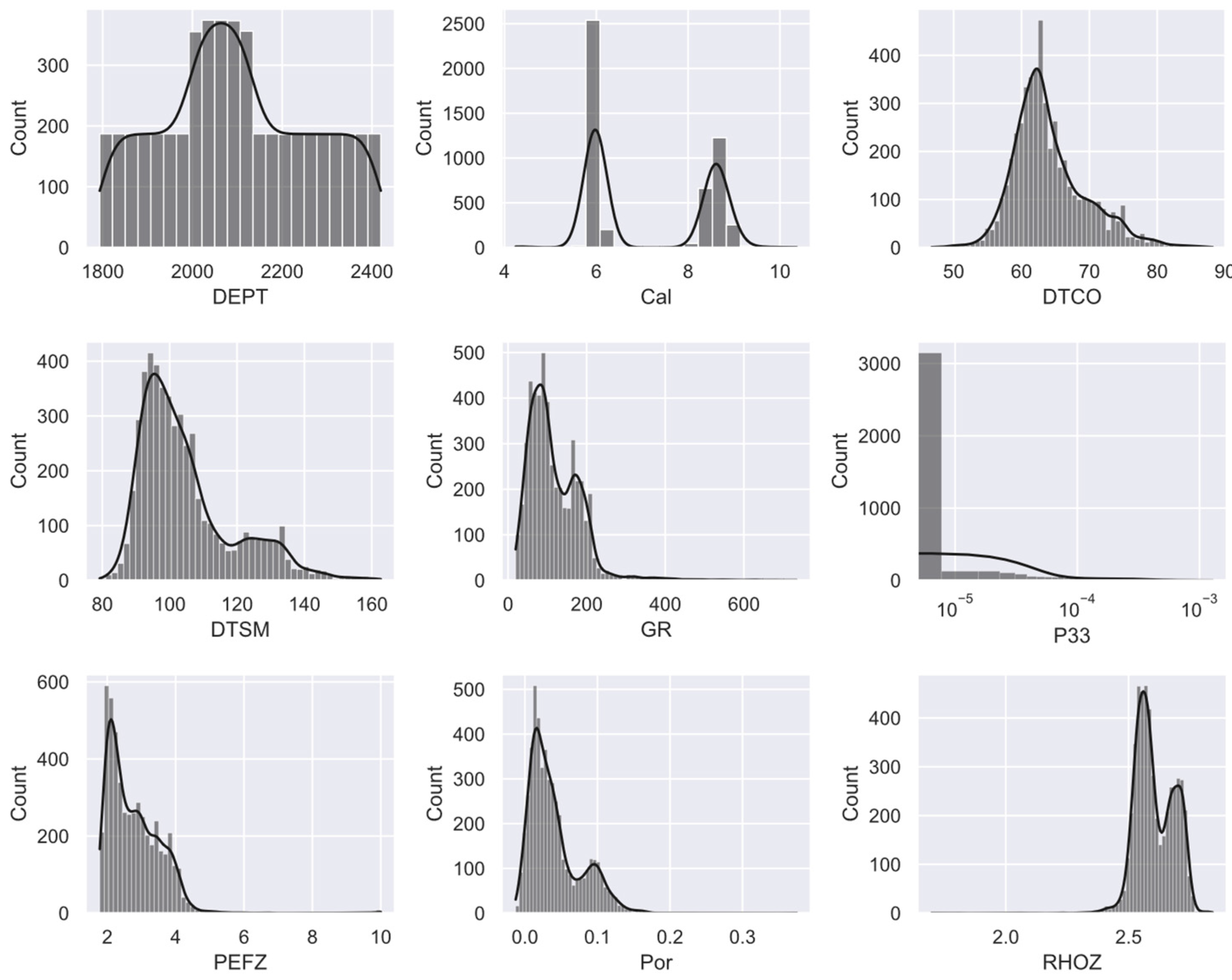


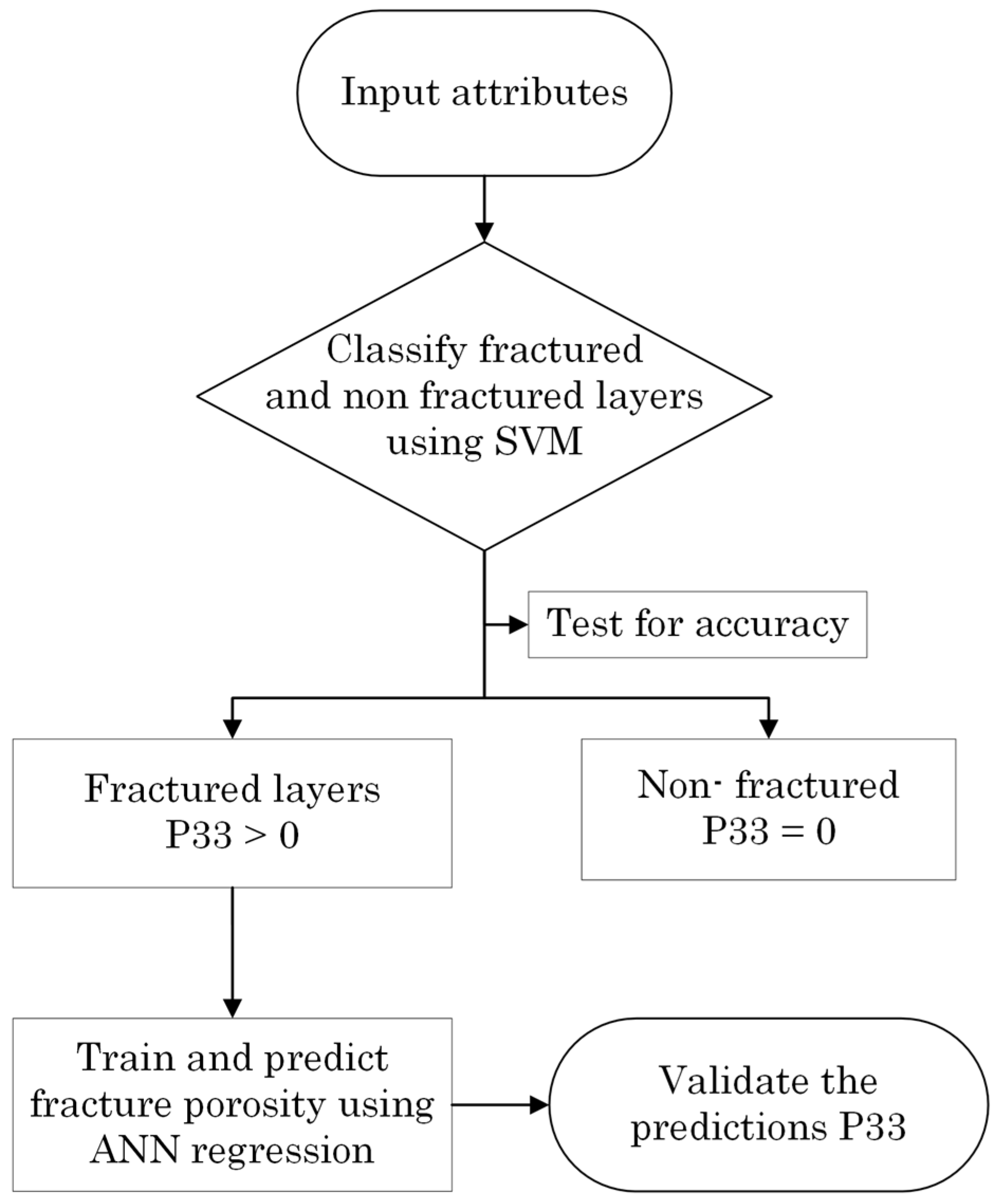


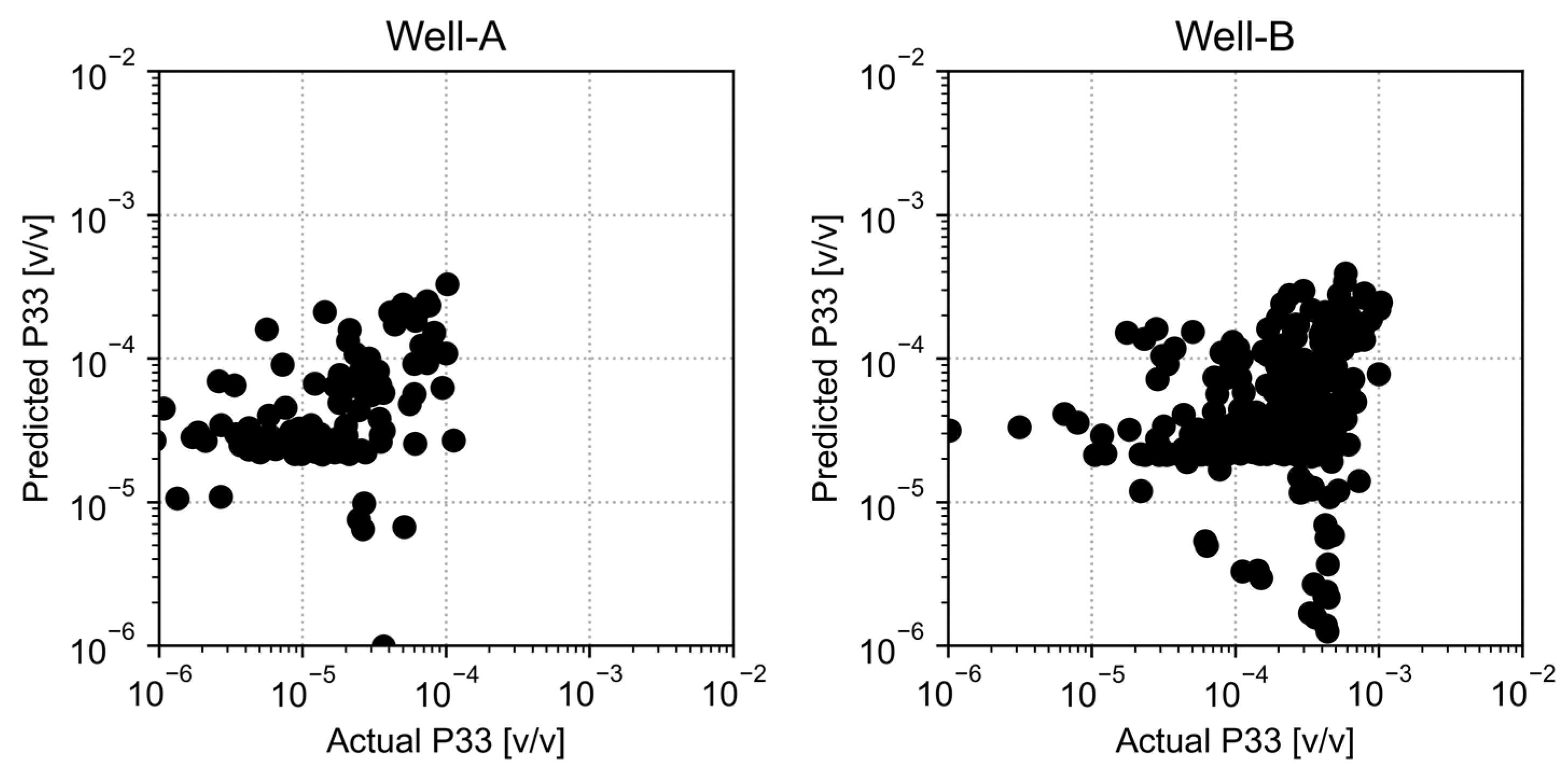

| Study | Methodology | Data Source | Key Findings |
|---|---|---|---|
| [27] | ANN | Caliper, Gamma Ray, Bulk Density, Neutron Porosity, Sonic Transient Time, and core data | ANN can be successfully used to predict the fracture density in boreholes using conventional well log data. |
| [28] | ANN | deep resistivity, density, neutron porosity and gamma ray | ANN has proven to be an excellent technique to estimate natural fracture porosity. |
| [29] | Bayesian Network Theory (BN)and Random Forest (RF) | Gamma-ray, deep resistivity, bulk density, neutron porosity, photo-electric. | BN Theory and RF were found to be effective in predicting the presence of fractures in different types of hydrocarbon-bearing rocks with a high degree of accuracy. |
| [30] | CNN (Convolutional Neural Network) | Seismic data, Vp, Vs, Image logs | The method offers a valuable means of evaluating fracture evolution in fractured reservoirs. Moreover, this research can serve as a benchmark for predicting anisotropic behavior and fracture porosity in other fractured reservoirs. |
| [31] | ANN | Image logs, gamma ray, caliper, photo-electric, deep resistivity, shallow resistivity | Interpreted FMI logs provide a trace while generating subsurface fracture maps using the statistical study of fracture radius, dip, and azimuth. |
| DEPT | Cal | DTCO | DTSM | GR | P33 | PEFZ | Por | RHOZ | |
|---|---|---|---|---|---|---|---|---|---|
| (m) | (in) | (us/ft) | (us/ft) | (GAPI) | (v/v) | (b/e) | (v/v) | (g/cc) | |
| count | 5008 | 5008 | 5008 | 5008 | 5008 | 5008 | 5008 | 5008 | 5008 |
| mean | 2098.965 | 7.150779 | 64.1306 | 104.8334 | 118.4989 | 7.74 × 10−5 | 2.788434 | 0.040624 | 2.605229 |
| std | 165.4286 | 1.339378 | 5.422916 | 13.9901 | 70.87042 | 0.00016 | 0.815019 | 0.035257 | 0.080526 |
| min | 1793.596 | 4.243306 | 46.75045 | 79.24234 | 19.42065 | 0 | 1.781257 | −0.01271 | 1.6979 |
| max | 2419.655 | 10.36588 | 88.15414 | 162.6788 | 734.3147 | 0.001278 | 10 | 0.37467 | 2.842013 |
| Well A: SVM algorithm predicted result | |||
| Real well logging data | |||
| P33 = 0 | P33 > 0 | ||
| Predicted well logging data | P33 = 0 | 1595 | 44 |
| P33 > 0 | 25 | 560 | |
| Well B: SVM algorithm predicted result | |||
| Real well logging data | |||
| P33 = 0 | P33 > 0 | ||
| Predicted well logging data | P33 = 0 | 1277 | 56 |
| P33 > 0 | 68 | 1383 | |
| RMSE | Pure ANN | Hybrid Model |
|---|---|---|
| Well A | 0.092 | 0.083 |
| Well B | 0.145 | 0.114 |
Disclaimer/Publisher’s Note: The statements, opinions and data contained in all publications are solely those of the individual author(s) and contributor(s) and not of MDPI and/or the editor(s). MDPI and/or the editor(s) disclaim responsibility for any injury to people or property resulting from any ideas, methods, instructions or products referred to in the content. |
© 2023 by the authors. Licensee MDPI, Basel, Switzerland. This article is an open access article distributed under the terms and conditions of the Creative Commons Attribution (CC BY) license (https://creativecommons.org/licenses/by/4.0/).
Share and Cite
Ifrene, G.; Irofti, D.; Ni, R.; Egenhoff, S.; Pothana, P. New Insights into Fracture Porosity Estimations Using Machine Learning and Advanced Logging Tools. Fuels 2023, 4, 333-353. https://doi.org/10.3390/fuels4030021
Ifrene G, Irofti D, Ni R, Egenhoff S, Pothana P. New Insights into Fracture Porosity Estimations Using Machine Learning and Advanced Logging Tools. Fuels. 2023; 4(3):333-353. https://doi.org/10.3390/fuels4030021
Chicago/Turabian StyleIfrene, Ghoulem, Doina Irofti, Ruichong Ni, Sven Egenhoff, and Prasad Pothana. 2023. "New Insights into Fracture Porosity Estimations Using Machine Learning and Advanced Logging Tools" Fuels 4, no. 3: 333-353. https://doi.org/10.3390/fuels4030021
APA StyleIfrene, G., Irofti, D., Ni, R., Egenhoff, S., & Pothana, P. (2023). New Insights into Fracture Porosity Estimations Using Machine Learning and Advanced Logging Tools. Fuels, 4(3), 333-353. https://doi.org/10.3390/fuels4030021






